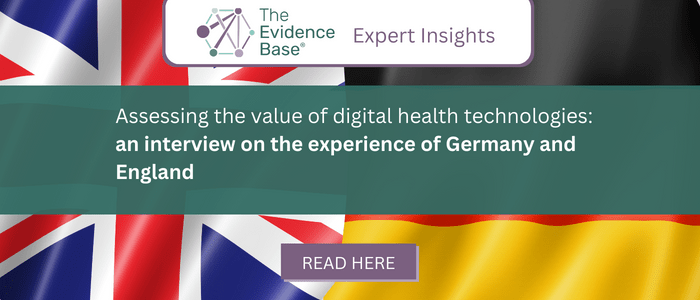Assessing the value of digital health technologies: an interview on the experience of Germany and England

Following the session at ISPOR—The Professional Society for Health Economics and Outcomes Research’s (NJ, USA) Virtual ISPOR Europe 2021 (November 30–December 3), Eleanor Bell from the Office of Health Economics (London, UK) and Pamela Aidelsburger from CAREM (Germany) discuss challenges and key learnings when conducting value assessments of digital health technology (DHTs). The experience of DHTs varies between the UK and Germany, despite being European neighbors, and our interviewees will explore the similarities and differences.
Please could you introduce yourselves, your organization(s) and provide a brief summary of your careers to date?
Eleanor Bell (EB): I am a Senior Economist at the Office of Health Economics (OHE). We carry out independent research and consulting in the fields of health economics, health policy and health statistics. Our work informs decision making about healthcare and pharmaceutical issues in the UK and internationally. I started my career working in development economics and after becoming particularly interested in the economics of health systems whilst based in West Africa, I decided to pursue an MSc in Health Economics and Decision Science at University College London (UK) in 2019. Since joining the OHE in 2020, I have carried out research on how the properties of a number of technologies, including vaccines, antibiotics and DHTs, may challenge our current approaches to health technology assessment (HTA).
Pamela Aidelsburger (PA): I am founder and CEO of the CAREM GmbH, a research and consulting company founded in 2004 in Germany. We specialize in benefit assessments, economic evaluation, market access and reimbursement. The company has built-up long-standing experience in these areas, especially in the context of early benefit assessment of drugs (AMNOG) and the evaluation process for digital health applications (DiGA) at the Federal Institute for Drugs and Medical Devices (BfArM). After finishing my medical studies in 1994 I worked as a medical doctor in trauma surgery. In 2000 I graduated with a Master of Public Health from the Ludwig-Maximillians University in Munich (Germany) followed by two years as a research associate at the Universities of Greifswald and Duisburg-Essen (both Germany). During my professional life I have performed a considerable number of HTAs, benefit assessments and economic evaluations for the industry as well as for public institutions.
What are the similarities and differences between how British and how German authorities approach DHTs? Why might this be?
EB: Evaluation of DHTs is a fairly recent challenge for HTA authorities and my perception is that to date the British and German authorities have prioritized addressing different dimensions of this challenge. In England, NICE (London, UK) has focused on testing its methods for assessing DHTs by launching the DHT pilot. The pilot has so far resulted in published guidance on two technologies, with five more currently under assessment. It utilizes the same methods and processes that are currently used to assess medical devices and diagnostics, but relaxes the evidence standards for DHTs meeting certain criteria. This is premised on the recognition that many DHTs not only provide significant patient benefit but can pose lower clinical risks than other types of technologies, alongside reducing operational and financial pressure on the healthcare system. This is because some technologies do not provide active treatment, but instead help patients monitor their conditions or facilitate communication between healthcare professionals. If NICE continues with this approach, it would speed up access to lower risk DHTs by lowering the bar for the evidence developers are required to present. In the first instance, however, the pilot aims to determine the appropriateness of NICE’s methods, before initiating mass assessment of DHTs.
PA: DHTs cover a broad range of technologies that can be applied in several medical settings like inpatient- and out-patient treatment or rehabilitation. Besides the well-established ways of assessing benefit of medical devices, Germany started a special benefit assessment approach for Digital Health Applications (DiGA) in 2019. A positive benefit assessment of a DiGA by the BfArM is prerequisite for reimbursement by health insurances. DiGAs among other aspects are defined as web-based technologies, which are used on mobile devices or computers by patients alone, or by the patient and the healthcare provider together. In contrast to what Eleanor said about the situation in England, Germany therefore focuses much more on the outpatient setting when establishing this new benefit assessment process. But there is at least one similarity: DHTs might show additional benefits in non-medical aspects as Eleanor pointed out. The methods for benefit assessments of DiGAs allow for the inclusion of additional benefits in an endpoint category called ‘patient-relevant improvement of structure and processes’. This includes, for example adherence, health literacy or patient autonomy. Interestingly, and this is another difference compared to England, costs or cost savings are not part of the assessment of a DiGA. Compared to England, the benefit assessment of DiGA started without a pilot testing leading to a listing of 28 assessed DiGAs in the DiGA directory between August 2020 and January 2021.
Germany’s process is well defined, based on narrow parameters and very selective. This makes it, compared to England’s, much faster. So far, the German process had a successful start. Nonetheless we should be aware that of 119 submitted applications, 50% were withdrawn by the manufacturers for several reasons. In many cases the manufacturers withdrew their applications as otherwise the BfArM would officially refuse due to insufficient evidence. In these cases, a new application can only be submitted after 1 year has elapsed.
How do both respective nations juggle stakeholder needs when considering the value of DHTs?
EB: By lowering the evidence standards that are required for low-risk DHTs, the DHT pilot aims to accelerate patient access to innovation, whilst simultaneously improving health system efficiency. Acceptance of non-quality-adjusted life year outcome measures is also helpful for developers because it reduces the cost, and lengthy waiting times, which can be associated with developing quality-adjusted life year evidence. This is a pragmatic approach which can produce ‘win-wins’ for all stakeholders, for those technologies which are judged to be low-risk to both patients and healthcare systems, such as the NHS. However, there are also many innovative DHTs which offer the potential for major patient benefits and improvements in healthcare system efficiency, but which are not necessarily cost saving. More work is needed to understand how we can rigorously assess the true value of DHTs so decision making can be optimized for the benefit of all stakeholders across the spectrum of DHTs. For example, many DHTs offer improvements in non-health outcomes such as operational efficiency: think, for example, of the streamlining of the delivery of care through utilizing digital rather than human monitoring of conditions, or of the time that can be saved when healthcare workers have access to fully integrated digital healthcare records. These non-health outcomes are often challenging to value, not least because the effects vary substantially with the healthcare setting.
PA: Germany is establishing a fast-track application process for DiGAs. After the manufacturer has submitted the application form to the BfArM, there will be a decision within 3 months. In the case of a provisional listing, the manufacturer can start a comparative study to show the additional benefit and the product will be reimbursed in the meantime. This creates a strong financial incentive for manufacturers, which are often start-ups with limited financial resources. The fast-track process will also enable a faster patient access to innovation than expected in England. Statutory health insurance providers, on the other hand, are interested in DHTs in general. Concerning DiGA, they demand a strict benefit assessment to assure an acceptable cost-benefit ratio. Interestingly cost-effectiveness evaluations of drugs or DiGAs are not common in Germany, as cost-effectiveness considerations are mainly addressed through price negotiations. The results of price negotiations between manufacturers and the National Association of Statutory Health Insurance Funds (GKV-SV, Berlin, Germany) are eagerly anticipated. The first price for a DiGA was set by the arbitration board as the manufacturer of Somnio and GKV-SV could not agree on a price. The original price of €464 per 90 days was reduced to €224.99 per 90 days. The next weeks certainly will give an idea if the concept of DiGA will be a success story.
As we know, the UK and Germany have had different experiences with COVID-19 but has the pandemic helped or hindered assessments?
EB: One silver lining of the pandemic has been in accelerating the digitalization of healthcare in the NHS. Stakeholders in the healthcare system have also been made more aware of the benefits offered by DHTs. Whilst I expect that NICE – like every other NHS body – has faced challenges in carrying out business as usual over the last 2 years, I anticipate that in the medium-term the experience of COVID-19 will be helpful in cementing the place of DHTs at the top of the agenda for HTA authorities.
PA: DHTs and DiGAs are assessed by federal institutions in Germany and to me it appears that the pandemic did not hinder the assessment process itself; although, a few things are handled differently right now, for example consultancies are performed online. But the pandemic pushed the idea of digital health and applications forward as they address medical needs exacerbated during the pandemic. This might be either because the number of patients needing treatment rose – as has been observed in the rising number of patients with depressive symptoms – or because access to healthcare providers became difficult. In the latter case, telemedicine or other digital health applications that can be used at home by the patient might provide a benefit. We also observed difficulties in conducting clinical trials as physicians, nurses or other care staff simply did not have time for these types of research activities.
In the future, what do you picture the DHT appraisal process to look like? Do you think we can learn from the other nation to achieve this?
EB: This is a fascinating question. For me, DHTs crystallize the tensions that exist in HTAs more broadly: the development of complex and rigorous methodologies and processes and the need to assess increasingly complex technologies. In the past, this has led to the recognition that the iterative and multifaceted nature of new technologies requires a pragmatic approach for their assessment. For DHTs to be appropriately valued, it will be critical to develop more accurate ways to measure relevant health and non-health outcomes associated with them, taking into account examples such as the role of that the user can have in determining outcomes. But equally, I hope that the pragmatism which is displayed in NICE’s Evidence Standards Framework for DHTs will persist. This would allow for the continuation of ‘light-touch’ assessments based on health outcomes evidence. Continuation would also create space for the consideration of non-health outcomes, not included in traditional value assessments, at least in a qualitative fashion. The flexibility of the Evidence Standards Framework for DHTs will also be an advantage as DHTs themselves evolve and might lead to other HTA bodies borrowing from it as HTA of DHTs becomes more widespread internationally.
PA: The use of different nation-specific methodological aspects of benefit assessment has always been debated by researchers, politicians and decision makers, as you can learn from each other in any case. As we can see with the the Regulation (EU) 2021/2282 and the Service Contract for the Provision of Joint Health Technology Assessment (HTA) Work Supporting the Continuation of EU Cooperation on HTA by the European Health and Digital Executive Agency (HaDEA), efforts are being made to synchronize activities regarding benefit assessments. Nonetheless, in my opinion each nation will keep its own system and the final decision-making power of declaring an additional benefit or declining it.
NICE. Evidence standards framework for digital health technologies, glossary. https://www.nice.org.uk/corporate/ecd7/chapter/glossary#digital-health-technologies-dhts [Accessed 1 February 2022]
NICE. NICE is gearing up for the evaluation of further digital health technologies as pilot project produces first result. https://www.nice.org.uk/news/blog/nice-is-gearing-up-for-the-evaluation-of-further-digital-health-technologies-as-pilot-project-produces-first-result [Accessed 1 February 2022]
NICE. Evidence standards framework for digital health technologies: user guide. https://www.nice.org.uk/corporate/ecd7/resources/evidence-standards-framework-for-digital-health-technologies-user-guide-pdf-11696158815685 [Accessed 1 February 2022]
Federal Institute for Drugs and Medical Devices. Digital Health Applications. https://www.bfarm.de/EN/Medical-devices/Tasks/Digital-Health-Applications/_node.html;jsessionid=970930C794712A4D0C1352AAB5009E97.internet552 [Accessed 1 February 2022]
EUnetHTA. EUnetHTA 21. https://www.eunethta.eu/eunethta-21/#:~:text=On%2017%20September%202021%2C%20the%20European%20Health%20and,for%2024%20months%2C%20and%20until%2016%20September%202023 [Accessed 1 February 2022]
European Union. Regulation (EU) 2021/2282 of the European Parliament and of the Council of 15 December 2021 on health technology assessment and amending Directive 2011/24/EU. https://eur-lex.europa.eu/legal-content/EN/ALL/?uri=CELEX%3A32021R2282 [Accessed 1 February 2022]
Disclosures:
Eleanor Bell is an employee at the Office of Health Economics. She has not received funding to conduct this interview. The Office of Health Economics has received funding to undertake projects in the DHT space. We received payment from Oxford AHSN to undertake a real world, quasi-experimental evaluation of a population-scale roll out of Sleepio. We also received payment from Big Health, the owner of Sleepio, to develop economic evidence to support their submission to the NICE Digital Health Technologies Pilot.
Pamela Aidelsburger is founder and CEO of CAREM GmbH. She has not received funding to conduct this interview. CAREM received payment from several manufacturers of Digital Health Applications, Medical Devices and from the pharmaceutical industry.
The opinions expressed in this feature are those of the interviewee and do not necessarily reflect the views of The Evidence Base®.






